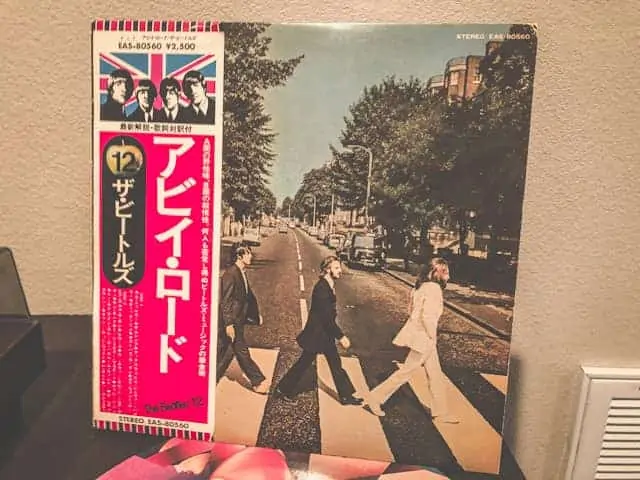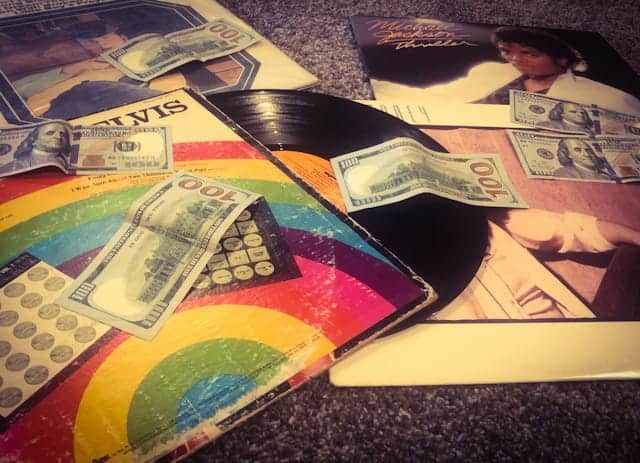Vinyl records are well-known to be great collector’s items, but how can you tell how valuable your records are? It may not be as easy as you may think. Grandpa might swear that he has millions in those old records but no clue how to go about appraising them. Many factors influence the collectability of any given record, though some may be more influential than others.
To value old vinyl records, there are many factors to consider, including whether it’s an original issue, who the artist is, the condition, and packaging. In addition, check if a record is a limited, foreign, or withdrawn edition as it will greatly change how much it’s worth.
By no means are those the only things that affect how valuable a record is, but they are some of the most important. In this article, we’ll be learning about how those factors come together to make a particular record a collector’s item or not.
Forget About Age
Many people would be surprised to learn that, unlike many other collectors’ items, the value of a vinyl record isn’t much affected by age. Artists’ older records indeed tend to be more valuable than later recordings, but that isn’t solely due to the record’s age; rather, it’s merely more likely that the older records were produced in limited quantity.
Many records produced in recent years are more valuable than records several times their age, which tells you what? Mainly, age almost always has very little to do with how much your record is worth. In specific circumstances that we’ll learn about later, it does matter – but don’t rely on age.
As such, you can put to rest the rumor that your friend’s pile of records isn’t worth thousands or millions solely because they’re old. If they are, it’s because of something else.
Check the Artist
Who recorded a particular record is an integral factor of how much it could potentially be worth. This makes sense on a surface level, right? Artists like Elvis Presley, The Beatles, and Pink Floyd are among the more well-known artists with collectible records. Naturally, these artists are more well-known, which generates interest in the value of their recordings.
An important point to note is that some artists’ records were only valuable when they were actively recording, and their value has dropped considerably since then. Others, like the ones named above, have remained collectors’ items throughout the decades.
Certain music genres, such as rock, blues, soul, and jazz, tend to have more valuable records than recordings from lesser-known genres like country or spoken word.
A counterpoint to this is artists that weren’t very popular in their lifetime but that became famous or musically influential later. A prominent example of this is The Velvet Underground, which never achieved much mainstream success but was very influential to later generations of musicians.
Primarily, the most valuable records of popular artists are recordings early in their careers or records produced in limited quantity or that weren’t popular in their time. Examples are promotional issues, limited editions, and artist’s lesser-known work. An example of this would be Pink Floyd’s earlier music.
Determine Scarcity
Like many things in this world, the prices of vinyl records are heavily driven by their scarcity. This means that if you have a million identical copies of a particular recording, it won’t be as valuable a record that was only made into a couple hundred or thousand copies. $10 or $10,000? The difference is in how rare your record is!
This isn’t a hard and fast rule, by any means, but it is a key indicator that you should keep in mind. Was your record a commercial success that was sold around the world? It may not be worth as much as you think, with a few exceptions.
Scarcity is almost always paired with another factor that makes the record such a collector’s item. This can be the band being famous or any number of obscure things, but if there’s no interest in a record, it doesn’t matter how rare it is – it simply won’t command high prices at auction.
Another factor that drives scarcity is that records wear out. In particular, records by Elvis or The Beatles were plentiful decades ago. But many of those records were damaged and lost due to abuse and being overplayed. Most commonly, most people simply weren’t thinking that they could resell the record in the future and didn’t take care of it. Kids, animals, weather, and other factors affect how fast a record will degrade.
Those who bought these records and kept them sealed or in mint condition will find that they have quite the valuable antique on their hands.
See If It’s Original
A very important thing to keep in mind is whether your record is an original pressing or a reissue. Reissues typically come with newer-looking sleeves and artwork and are usually a dime a dozen. Thankfully, there are some easy ways to tell whether your record is an original or a reissue.
Some of these ways are:
- Check the spine of the sleeve for a four-letter and number combination, such as ABCD-1234. Reissues after the first few pressings have different letter and number combinations.
- Records before the 1980s do not have a barcode on the sleeve, making it easy to tell off the bat whether you may have something valuable on your hands.
- Compare catalog numbers using the internet to see whether your record is original or not. Some records’ catalog numbers change, so it’s important to check online. These are two letters followed by numbers, such as “EB 4567.”
Find Out If It’s Limited Edition
Limited edition records that were produced in limited quantities on purpose are almost always valuable. When interest in records died down during the advent of CDs, record companies figured out that they could announce a ‘limited run’ of a record. It would quickly sell out instead of regular records that may languish on shelves or in stock rooms.
Sometimes these records are colored differently than ordinary records to distinguish the two. They may be black or any other color – sometimes they’ll be picture records. Picture discs are a kind of record made with a special process that overlays a picture or graphic, typically the album cover, onto the actual playable surface.
Promotional records have been made into picture discs as well, but regardless of this distinction, picture disc records are valuable items. If you have one, hold on to it!
See our list of the 15 Most Expensive Vinyl Records Ever Made.
Check if It’s a Promotional Issue
Promotional issues are records pressed before retail copies of a record and are the records that radio stations receive to play on the air. These records can be colored, but ‘white label promos’ have become increasingly popular among collectors. Some records are only made in promotional issues and are highly sought after if the artist is popular – a lesser-known artist’s promo-only record won’t sell for nearly as much.
Promo records are sometimes different in other ways, too. Occasionally a record will have a different ending on the promo record than a stock copy. Naturally, these kinds of records sell for a substantially higher amount than other promo issues.
Some records are only made in promo issues, like compilation albums or made by radio broadcasts. If it’s a popular artist, then these promo-only records will go for a high price. Less popular artists’ promo-only records won’t sell for nearly as much due to lower interest in their material.
While promo records typically always sell for more than their stock counterparts, in a few cases, the promo may actually be more widely available than the stock record, usually due to poor sales. In general, though, you can usually count on promotional issues to be pricier than commercial records.
Check What Recording Label Pressed Your Record
This may seem like common sense, but major recording labels have the facilities available to produce and distribute records in the thousands or millions. In contrast, smaller labels cannot afford this output. On the other hand, artists have a better chance of signing on with a smaller label during their early careers. Frequently, successful artists moved on to a bigger label that could provide them with a much wider audience and more money and fame.
In the case of an artist that jumped from a small label to a big one, their early work on the smaller label will likely be more valuable. This is because of natural scarcity, which we discussed earlier.
The artist wasn’t as popular starting out, and so there wasn’t much interest at the time. If only a few hundred or thousand copies were made of an early album and then the artist went on to make millions of their next album, those early records will be hard to find and valuable to collectors.
Determine Audio Format
Records are produced in three audio formats: quadraphonic, mono, and stereo. Quadraphonic records were produced for a very niche market and so are hard to find. Naturally, these records’ price depends on the interest in the artist and other factors as well.
Monaural or ‘mono’ records only have one sound channel, even if the record was recorded with multiple microphones. Until 1957, all records were pressed as mono. From 1957 until the 70s, records were sold in either stereo or mono format.
Quadraphonic records made with four channels of sound were generally produced for niche types of records and broadcasts. Being an unusual type of record that requires special equipment, they’re often looked for by collectors.
The advantage of stereo records was that two channels of sound could be recorded and played back at the same time, thereby increasing the quality of the music and providing a more three-dimensional sound than mono. Due to the way they were made, stereo records required stereo record machines with different cartridges. (See How Do Vinyl Records Play Stereo Audio?)
A common problem was that people would try to play stereo records on mono record players. In this case, the needles of the mono equipment would damage stereo records. Some people found that they could replace a mono record machine’s cartridge with a stereo cartridge, but it altered the sound in a very unpleasant way.
From the 60s onward, mono records became increasingly hard to find as stereo took over. The price of a particular record in mono or stereo form is mainly affected by the record’s age.
See our buyer’s guide on the 6 Best Vinyl Record Players With Speakers
Check if It’s a Foreign Edition
Foreign editions of records by popular artists are popular collector’s items. Many records by American artists have been released in other countries with different titles or covers. In general, collectors will look for foreign editions of records of their favorite artists.

Also, many records have been pressed with unique vinyl or other features. An example of this is Japanese records, which were often printed on red vinyl with paper sashes called ‘obi’ with information in Japanese for consumers. Japanese records were pressed with a different process that gives them a distinct sound from American or British records. For all these reasons, Japanese records are of particular interest to collectors.
Another area collectors pay attention to is when an artist isn’t American, such as the Beatles. The Beatles released albums before they were popular in America and had their records pressed and sold there. For this reason, collectors with interest in the Beatles will seek out their British releases.
Find Out If Your Record Was Withdrawn
For any number of reasons, a recording company or artist may choose to withdraw a record from circulation. It could be a decision made by the recording label, artist, or even retailers not liking a release for some reason. Because very few of these records were made and made it out into the public, they’re very sought-after by collectors.
The most well-known withdrawn record of all time is called the ‘butcher cover’ of the Beatle’s album Yesterday and Today. The album was originally a picture of the Beatles in white coats covered in raw meat and broken doll parts. Due to retailer outrage at the cover’s perceived anti-Vietnam War sentiment, the record was withdrawn. In 2019, a signed copy of this record sold for $234,000 at auction.
Prioritize Sealed and Signed Records
When it comes to record albums, you’ve already learned about a myriad number of ways to identify valuable records. Two more of these factors that can make prices skyrocket are records that are in original shrink wrap and records that have been signed by the recording artist.
Even if a record without shrinkwrap hasn’t been played, the same exact record in its original packaging would be worth much more. It can be difficult to identify a mint record in the original packaging as opposed to repackaging for shipping or sales purposes, so always be certain with other methods that the record is a valuable version. If you’re unsure, use other methods or check your record against an online database to be sure.
Signed records, too, command high prices. Even if an album isn’t necessarily valuable for other reasons, an artist’s signature alone may give it value. Personalized autographs such as “Best wishes to…” are not as valuable as the artist’s signature alone. Another thing to keep in mind is that if the artist is a group, it needs all the members’ signatures, or it may not be as valuable.
Keep Your Records in Good Condition
It goes without saying that a record’s condition will affect how much it is worth. Whether a record was opened, played, and taken care of are all factors that determine the potential price.
When records were introduced, and the following decades, most records weren’t kept in the kind of condition collectors look for (mint condition). Records were stored outside sleeves, written on, overplayed, and damaged in countless types of ways. Record players that played multiple records side by side, like jukeboxes, were particularly prone to scratching records.
While there may have once been thousands or millions of copies of a specific record, time and damage have reduced this in an example of natural scarcity. Ideally, a record is most valuable in the original plastic packaging, as if it’s brand new. Failing that, the fewer times a record has been played, the better.
Records that have been played modestly often have modest prices, unless they are of a particularly rare record that doesn’t exist in mint condition at all.
Final Thoughts
There are so many factors that determine whether a record is valuable that it can be hard to keep track of them. Sealed, signed, and mint condition records are some of the most ideal records one can own from a collector’s perspective. When selling, it’s important to check if your record is by a popular artist, is an original in good condition, and has any unusual characteristics that might make it valuable at auction.
Keep an eye out for any limited or foreign editions too! Now it’s time to sort through those old records with an appraising and educated eye.
Recommended Reading:

